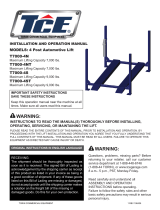
2
you should contact a contactor or building inspector for an inspection. They
can evaluate your concrete with a GPR (ground penetrating radar). These
devices can detect both ferrous and non-ferrous materials. They can also
detect voids in concrete and thickness.
Concrete Compressive Strength and Surface Condition:
• The minimum standard for concrete strength is 2500 psi.
o A good way to check the compressive strength of the foundation is with a
rebound hammer. A rebound hammer will provide a reading on a scale that
can be converted to PSI. It is recommended to take as many as 12 hits on the
surface of the concrete in the area around installation site.
o Another quick test to evaluate the concrete is to scrape the surface of the
foundation with the edge of a small standard screwdriver. If the surface is
easily scratched with deep grooves, your concrete may not meet the
minimum requirements and should be evaluated by a professional and/or
with a rebound hammer.
• A slab which contains numerous large cracks caused by settlement of the
support of the supporting sub grade, prior extreme loading, or improper
finishing or curing should not be considered adequate for shelter anchorage.
Small cracks are acceptable, 1/32” or smaller. If these conditions occur, you
should have your concrete evaluated by a professional.
• It is important to determine the location of any construction joints where the
reinforcing may be discontinuous; this would make the slab inadequate for
shelter anchorage. Sawn control joints are acceptable, provided reinforcing has
not been cut. See Minimum Concrete Reinforcement above.
Anchor Bolt Installation and Inspection
The National Storm Shelter Association (NSSA) recommends following
engineering specifications for anchor type, size, and capacity. The NSSA also
recommends following manufacturers installation procedures.










